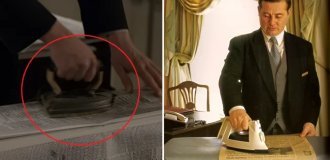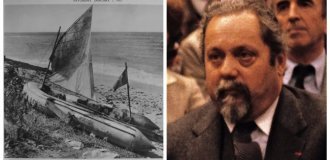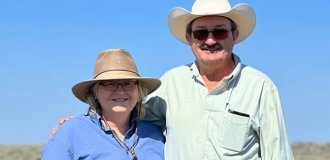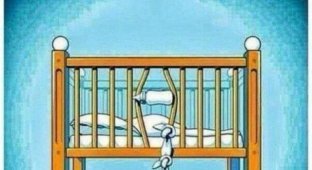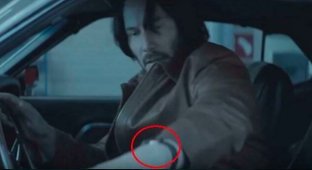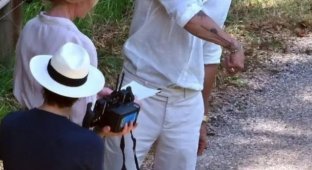Stars and Stripes Chuck - hero of action films and memes (21 photos)
If you want to understand what kindness with fists is, look at Chuck Norris. A man with a good-natured face and a completely ordinary build, from film to film he deals with villains of various stripes with his bare hands. 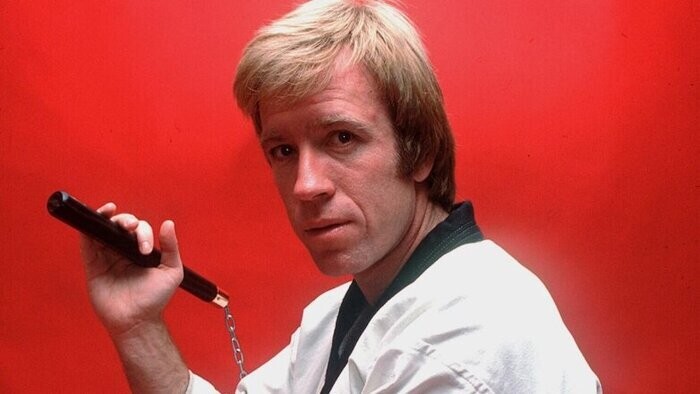
True, for today's youth Norris is more of an Internet meme character, but for those who saw the era of video stores, he is a hero whose images in films motivate them to immediately take up sports and protect the weak.
Good guy
Norris's films cannot be called masterpieces, but viewers were often captivated by the fact that, unlike many other popular actors who played tough heroes, Chuck is a real expert in hand-to-hand combat. Norris came to cinema from combat disciplines, while action stars often train only for a role. He did not set himself ambitious artistic goals. “I’m not up for an Oscar,” Norris told Steve McQueen when his films were panned by critics. Norris simply wanted to make a movie about the struggle between good and evil, in which the fight scenes would be well choreographed. 
Short, naturally unathletic (by his own admission), he was closer to the viewer than Stallone or Schwarzenegger, who looked like Olympic gods. Among the predominantly liberal-minded Hollywood stars, Norris looked like a black sheep: he did not hide his Puritan views and was sincerely worried about the fate of America. He did not film patriotic action films for the sake of opportunism: this man is quite seriously convinced that the death of American soldiers in Iraq and other distant countries is justified by the lofty goals for which these campaigns were launched.
In 2012, Norris starred in Stallone's The Expendables 2, but in general, in the 21st century, he attracts more attention for his near-political statements than for his new roles. Politics for him is a battle between good guys and bad guys, like in the Wild West, as it is depicted in Westerns. And Norris supports those whom he considers to be good guys: Reagan, Bush Sr. and Bush Jr., Trump. 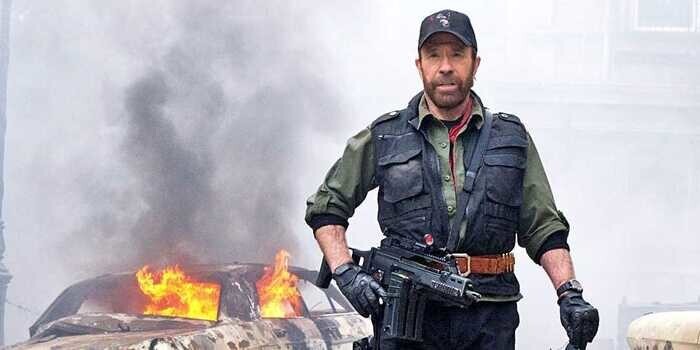
Baby Carlos
Norris is one of those movie stars who, neither in childhood nor in adolescence, did not even think about a film career. He had neither outstanding acting abilities nor good physical characteristics. He didn’t even have great ambitions: young Carlos Norris dreamed of working in the police. He imagined that, having received a uniform and a badge, he would be able to punish the “bad guys”, as John Wayne and other heroes of his favorite Westerns did.
But his fate turned out completely differently.
Norris's life story itself is good material for a film. Barely surviving at birth, a frail and shy child from a poor family becomes a multiple world karate champion and a reference action hero. Perhaps someday his autobiography “To Spite All Troubles” will actually be filmed. 
Although Norris had a mixture of Irish and Indian blood flowing through his veins, his parents gave him the Spanish name Carlos - in honor of their friend, the pastor Carlos Berry, who served in Ryan, Oklahoma, where the future "cool Walker" was born. The person who shaped Norris’s worldview for the rest of his life was his mother Wilma. Despite her difficult life, she always maintained what Chuck describes as “spiritual and practical stability.” Wilma was a deeply religious person, and so was her son.
The father, Ray, was rather a negative example. Overall a good person, a World War II veteran, he drank a lot, which was a big problem for the family. The actor explains his drunkenness by his father’s internal weakness. “Now I understand that dad just couldn’t stand confrontation. In this way he tried to escape from any problems. Unfortunately, dad spent most of his life like that – constantly running away,” Norris writes in his memoirs. 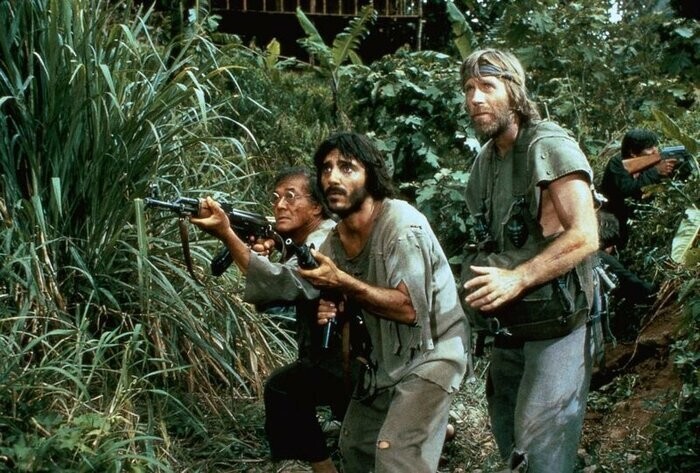
Important Lessons
And although little Carlos did not want to be like his father, at first he, just like Ray, tried to run away from trouble. At school, the frail and timid Norris was constantly bullied by the big Bobby. Carlos, realizing that Bobby was physically much stronger than him, tried not to get involved with him, preferring not to fight, but to run away from the offender. So he returned home every day in a hurry, pursued by Bobby, until the gas station owner, who was watching all this, intervened.
He called Carlos over and said, “It’s time to stand up to Bobby. You can’t run from your fears all your life.” Carlos heeded the advice, and, overcoming his horror, met Bobby face to face. The fight was not easy, but Norris defeated the enemy, who since then not only stopped terrorizing the future sensei, but also became friends with him. Carlos learned his lesson. Again, a ready-made episode for a motivational movie. When Norris was 16 years old, his parents divorced. Stepfather George Knight became for Norris an example of humanity and fatherly care, which he lacked throughout his childhood. In addition, George convinced his stepson to take up sports, which had never even occurred to Carlos before. 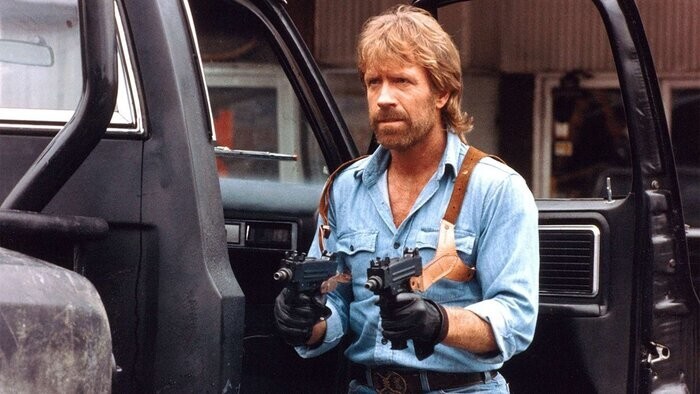
One day, Ray Norris came to his former family's house, intending to "deal with George." This situation became a milestone in Carlos's life, just like the one when he stopped running from the school bully. Carlos stood up for his quiet and intelligent stepfather and went into confrontation with his father. A fight was brewing. Looking at his son, Ray “backed off.” “On that fateful day I learned another important lesson about fear. True courage is not the absence of fear, but control over it,” says Norris.
He did not immediately manage to get a job in the police. Therefore, Norris decided to first join the military police of the Air Force in order to quickly get a job in civilian life after leaving the army. 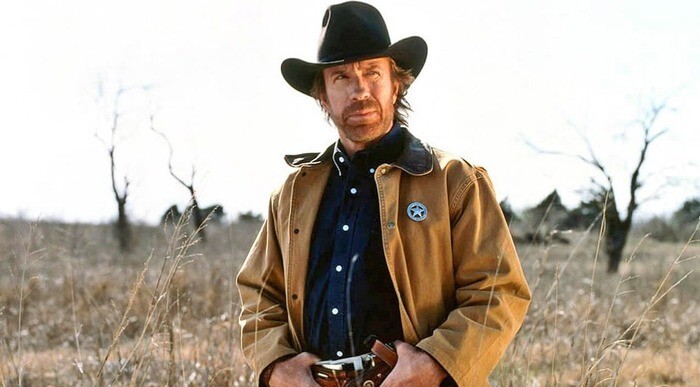
Transformation into Chuck
In the army, his colleagues were surprised by his Spanish name and renamed Carlos Chuck. Since then it has been like this. After spending several months in boot camp, Norris felt stronger not only physically, but also mentally: he realized that he was ripe for marriage, and proposed his hand in marriage to Diana Holecek, a girl with whom he had been in love for a long time. Shortly after the wedding, soldier Norris was assigned to South Korea, which he was not at all happy about at first. However, this event decisively influenced his life.
First of all, in Korea, Norris became an ardent patriot. Having looked at the poverty in which ordinary Koreans lived in the village of Osan, where he served, Chuck realized that in comparison with this, his extremely modest American life looked like a completely well-fed and prosperous life. “I realized that I was lucky to be born an American,” Norris recalls. 
Another key event was meeting Mr. Ahn, a teacher of Tang Soo Do, a Korean form of karate. In his first weeks at the base, Chuck had already practiced judo and even broken his collarbone. Tansudo opened up even more tempting prospects.
Without even thinking about waiting for the bone to heal, Chuck began training through the pain, and soon returned to judo. It was a real school of self-discipline and tempering of spirit.
The Koreans even began to respect such a crazy American. Soon he broke his arm while trying to split a tile at a demonstration performance, but he already perceived the injuries as a trifle. It is not very clear where such determination and ruthlessness towards oneself came from in the seemingly gentle and quiet young man that Norris was before the army. 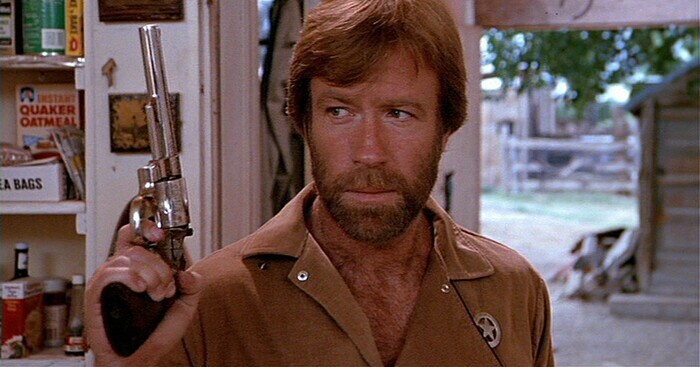
In martial arts, Chuck, again, did not set any big goals for himself: he just wanted to be well prepared for police work. However, he soon passed the black belt exam. After leaving the army in 1962, Norris took a job as a clerk at a small airline. He never stopped dreaming of working in the police. But there was no vacancy, and young Chuck needed to support his family - his first child, Mike, had just been born. At home, he began giving karate lessons - first to his younger brothers Wieland and Aaron, and then to everyone. Interest in martial arts grew, and things were going better for Norris the coach. Finally, he decided to concentrate entirely on teaching, deciding that becoming a police officer was simply not destined for him.
Meeting the Dragon
In the mid-1960s, Norris began competing in karate tournaments, hoping it would be good publicity for his school. He lost the first two tournaments, but then he began to win. At the 1967 All-American Championship, as he writes in the book “To Spite All Troubles,” Chuck met Bruce Lee, who came up to congratulate Norris on his victory. In one of the interviews, he names a different date and place: 1965, filming of the television series “The Green Hornet.” Other details of the meeting remain unchanged: discussing fighting techniques, they sparred in the hotel corridor until four in the morning. “Surprisingly, no one reported to hotel security about two crazy people fighting in the hotel hallway!” – Norris writes. 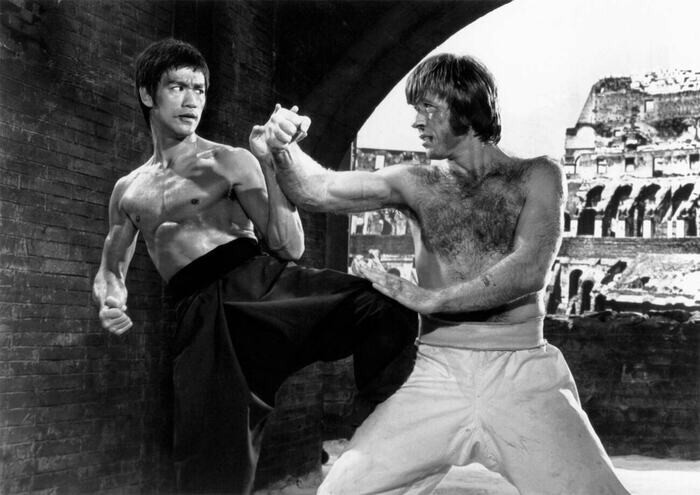
In “Way of the Dragon,” Chuck Norris played a negative hero almost for the only time in his entire career. Later, when he began making films himself, all his characters were positive
Acquaintance grew into friendship. Bruce told Norris that most of all he wanted to make a career as a film artist. Norris wished him well and gave him advice to use high kicks to the head, as they look very impressive. In 1968, Lee offered Norris a small role in the film The Wrecking Crew, where he worked on stunt choreography. Chuck had to fight Dean Martin.
Norris agreed, having no idea that this part-time job would be the start of his film career. During filming, he became convinced that he was unable to properly pronounce the tiny line assigned to him, despite the fact that he had carefully rehearsed it for several weeks.
Four years later, Bruce Lee, who by that time had already become a star, invited Norris to his film “Way of the Dragon.” Chuck was supposed to play the main antagonist. The climax of the film - the final battle - took place in the Roman Colosseum. Before filming, Bruce asked Norris to gain some weight to look more massive, which Chuck easily managed with spaghetti and Italian ice cream. 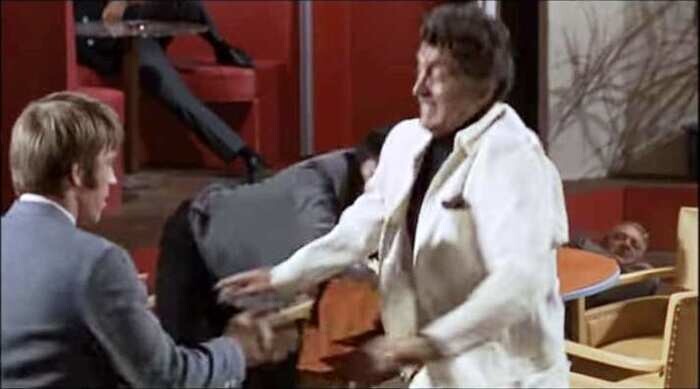
"Wrecking Crew"
Not only the film itself, but also the battle scene in the Colosseum in particular became a classic of the genre. Despite this, Chuck did not take his participation in the movie seriously. He was successful as a trainer and as a competitive fighter. He even developed his own martial discipline - Chun-Kuk-Do, in which he combined all the best of the traditional directions known to him.
Life forced
According to Norris himself, he would never have gone into filmmaking if he had not one day found himself on the verge of bankruptcy. The company, which bought several schools he opened, as well as the Chuck Norris School brand itself, failed to cope with the task of creating a worldwide franchise, and the project was threatened with complete liquidation. Norris was worried not only about money, but also about his good name. To save him, he undertook to pay off the company's debts, as a result of which he almost ended up on the street. 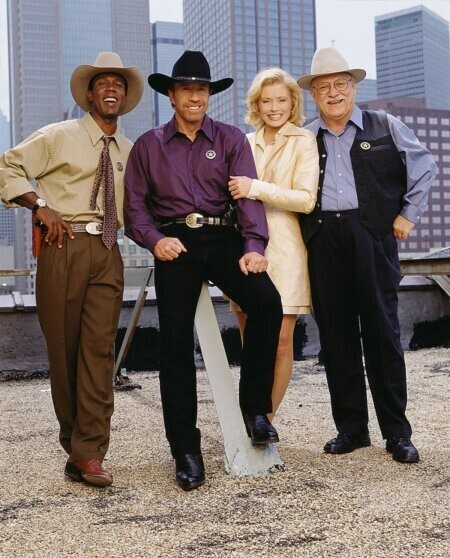
"Cool Walker"
Hoping to improve his financial condition, Chuck began giving private lessons, and soon many celebrities appeared among his clients: Elvis Presley’s wife Priscilla, the band The Osmonds and others. Actor Steve McQueen, a real megastar at that time, also turned to him. Steve brought his son to Norris, but soon decided to take up karate himself. McQueen urged Norris to try his hand at films, although he did not offer any patronage. Having estimated how many unemployed actors there are in Hollywood, Chuck became despondent. But McQueen encouraged him, recalling the motivational phrases that Norris himself liked to say during training.
Chuck finally decided to give it a try. He was 34 years old, had won the world karate title six times in a row and decided to retire from his competitive career, retiring undefeated. Norris enrolled in an acting school, and one where former military personnel were given a discount - he could not afford to pay the full cost of the courses. 
He did not finish school: one day one of his classmates criticized his acting abilities so much that Norris was offended and left. Finding a job as an actor seemed like an impossible task, especially since after the death of Bruce Lee, film companies decided that the fashion for films about martial arts was over. Filming in low-budget films like “Yellow-faced Tiger” or “Offender” did not bring Norris either fame or money.
And then the thought struck him: instead of trying to fit into other people’s projects, it was better to come up with a role for yourself and make your own film. “When I became an aspiring actor, I imagined the hero I one day hoped to play. By nature I was a quiet and reserved person, but I always adhered to strict principles in life. I wanted to create a hero with similar qualities and values—a man who used karate to fight injustice,” Norris writes. 
This is how the film “Good Guys Wear Black” (1978) appeared, in which Chuck recruited friends from karate school to work on it. It was not possible to sell the script to large studios. The investors found by the producer did not want to give money for such a film, but Norris convinced them. The film was also distributed independently, because the distributors did not believe in success. Critics laughed at the film.
Chuck was preparing for failure, but the wise McQueen reassured his friend: “In the end, it all comes down to the fact that if your films turn out to be profitable, you will continue to act. You can have the best reviews in the world, but if your film fails at the box office, you will join the ranks of the unemployed.” 
Fame and Violence
“The Boys” collected a considerable amount at the box office, and the producer asked Norris to prepare for the next film. The Power of One (1979), The Octagon (1980), and Eye for an Eye (1981) were made in the same independent way. Norris's first film for a major studio (Columbia) was 1982's Silent Wrath. Norris's fame as an action hero grew. In each film, he embodied his concept of the struggle between good and evil. Motivated by the best of intentions, Norris was deeply shocked when his paintings began to be criticized for demonstrating excessive violence, and his characters were called a bad example for young people. The zealot of morality was not ready for such a turn.
But Norris continued to stick to his line. His younger brother Aaron often helped him with his paintings. In memory of another brother, Wieland, who died in the Vietnam War, they made the film “Missing” (1984), which later became part of a trilogy of the same name. 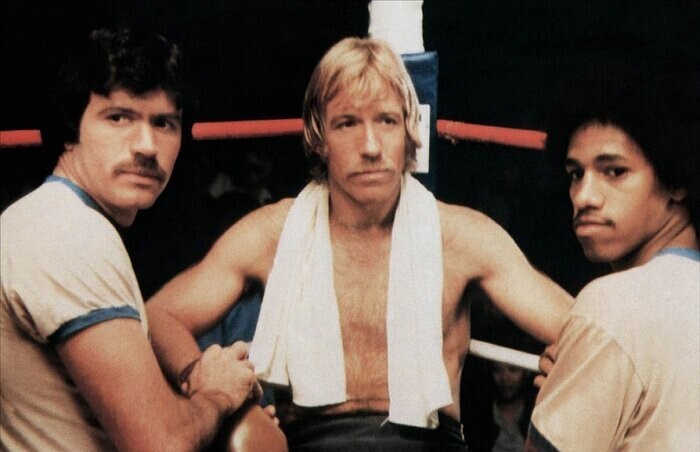
The 1980s were the golden era of action movies, and Norris was one of its leading heroes. He was also known in the Soviet Union: on the first videotapes, in the first video stores, there was always something like “Octagon” or “Lone Wolf McQuaid”. When Norris arrived in Moscow in the mid-1990s, he had to literally run from restaurant to restaurant, because those who grew up watching his films did not give the actor a moment’s rest.
Norris's success forced film companies to reconsider their approach to films about martial arts and opened the American market to Jackie Chan and other actors of this kind.
Soberly assessing his capabilities, Norris tried to adhere to the boundaries of the genre. On the one hand, fans always got what they wanted from their idol, but on the other, when action movie creators began looking for new forms and techniques in the 1990s, Norris found himself out of work. 
When he was 53—an old age for action movies—and straight-up movies about good guys and bad guys had fallen out of fashion, he took on the television series “Cool Walker: Texas Justice.” In it, Chuck expressed all his orthodox ideas about harsh justice, which were no longer in demand in big cinema. Among other things, the conservative Norris found the world of Ranger Walker a refuge of sorts during the liberal era of Bill Clinton's presidency.
American Recovery Plan
Norris's path was winding, but in the end he nevertheless became what he wanted to be since childhood: a man fighting evil, albeit not in the police, but on the screen. And not just on screen: in 1990, with the support of President George H. W. Bush, he launched the Kick the Drugs Out of America initiative. It gave schoolchildren the opportunity to study martial arts for free. Now the project has been renamed Kickstart Kids and covers about 10 thousand students. 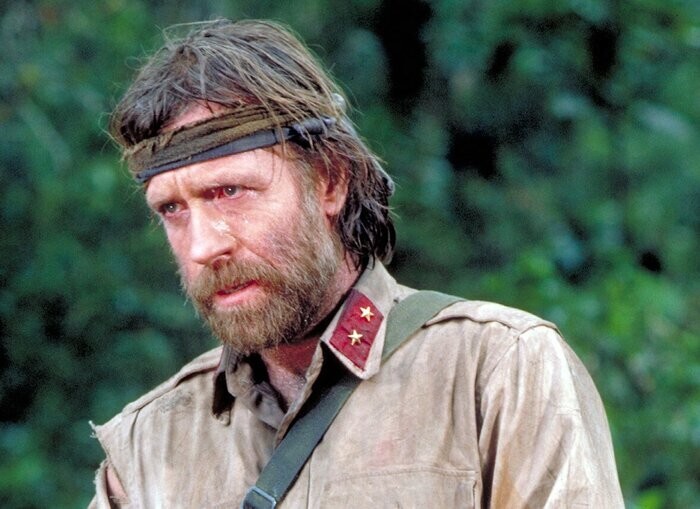
Norris likes to repeat that karate, taekwondo and other martial arts not only teach a person to fight, but, most importantly, awaken in him a sense of confidence and usefulness. And the absence of these feelings gives rise to aggression, addiction to drugs and many other bad things in people.
Today, Norris is also a fairly successful writer, publishing not only autobiographies and books about martial arts, which are natural in his position, but also prose and political journalism. In the mid-2000s, he published the Western duology “Riders of Justice” and “The Threat to Justice,” and in 2008, the political and ideological work “Black Belt Patriotism: How We Wake Up America Again.” In this book, which, by the way, sold very well, Norris talks about the revival of the country in the form in which the founding fathers thought of it. He describes the current state of American society as follows: “a nation divided and not knowing what to do.” 
Among the main problems of the United States, he names the decline of morality, the collapse of the traditional family, the spiritual and physical apathy of citizens, as well as consumerism and insecurity of state borders. Norris proposed his own solutions to these problems, but soon after the book was published, Barack Obama won the presidential election, and these ideas were not in much demand. When Obama was seeking re-election in 2012, Chuck released a video claiming that Obama's new term would be the first step in leading America into a "millennium of darkness."
In 2009, Norris supported the movement for the state of Texas to secede from the United States, which arose as a reaction to the “anti-people” (according to Texas activists) policies of Washington.
Another notable public gesture by “Cool Walker” concerned his proposal to ban same-sex marriage in the state of California. The good-natured Chuck became militant when it came to dismantling traditional foundations. 
Chuck Norris can do anything
The common cliché “man-legend” in the case of Chuck Norris has one additional dimension: by the will of wits on the Internet, he really turned into a hero of myths, a kind of modern Hercules. It all started in 2005 with jokes on the humor forum Something Awful and resulted in the emergence of tens of thousands of so-called “facts about Chuck Norris.” The heroic film image of the all-conquering Chuck, which seemed naive and even funny to some, has become material for modern folklore.
“Chuck Norris threw a grenade and it killed 50 people. Then she exploded." "Chuck Norris can strangle you with a cordless phone." “Chuck Norris doesn't wear a watch. He decides what time it is." “Chuck Norris was bitten by a cobra. Cobra is dead." In 2009, these and other “facts” were published as a separate book, but since then more and more new ones have appeared on the Internet. 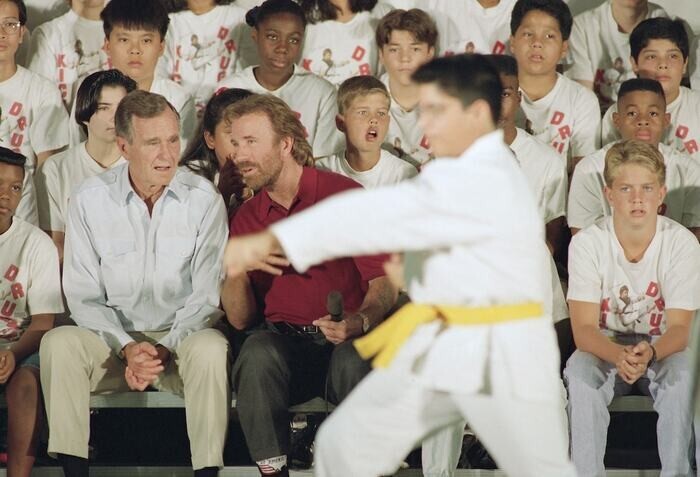
Chuck Norris is a staunch supporter of the US Republican Party. In the photo he is with George HW Bush
Norris himself at first did not know how to react to this, but then he decided that this was also fame, and even starred in advertising using these factoids. Some see good humor in them, others see caustic sarcasm, but one thing must be admitted: people clearly still need Chuck Norris.
